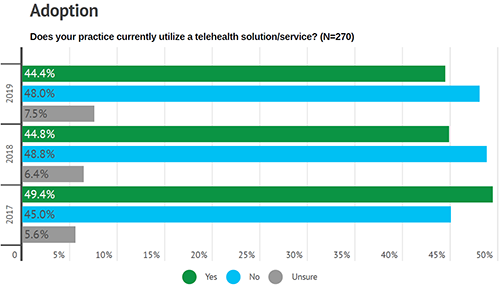Medical laboratories may find opportunities guiding hospital telehealth service physicians in how clinical lab tests are ordered and how the test results are used to select the best therapies
Telehealth is usually thought of as a way for patients in remote settings to access physicians and other caregivers. But now comes a pair of studies that indicate use of telehealth in inpatient settings is outpacing the growth of telehealth for outpatient services.
This is an unexpected development that could give clinical laboratories new opportunities to help improve how physicians in telehealth services use medical laboratory tests to diagnose their patients and select appropriate therapies.
Dual Surveys Compare Inpatient and Outpatient Telehealth Service Use
Definitive Healthcare (DH) of Framingham, Mass., is an analytics company that provides data on hospitals, physicians, and other healthcare providers, according to the company’s website. A survey conducted by DH found that use of telehealth solutions—such as two-way video webcams and SMS (short message service) text—has increased by inpatient providers from 54% in 2014 to 85% in 2019, a news release stated.
Meanwhile, a second Definitive Healthcare survey suggests use of telehealth in outpatient physician office settings remained essentially flat at 44% from 2018 to 2019, according to another news release.
For the inpatient report, Definitive Healthcare polled 175 c-suite providers and health information technology (HIT) directors in hospitals and healthcare systems. For the outpatient survey, the firm surveyed 270 physicians and outpatient facilities administrators.
DH’s research was aimed at learning the status of telehealth adoption, identifying the type of telehealth technology used, and predicting possible further investments in telehealth technologies.
Most Popular Inpatient Telehealth Technologies
On the inpatient side, 65% of survey respondents said the most used telehealth mode is hub-and-spoke teleconferencing (audio/video communication between sites), Healthcare Dive reported. Also popular:
- Patient portals or apps (40%);
- Concierge services (29%);
- Clinical- and consumer-grade remote patient monitoring products (13% and 8%).
Fierce Healthcarereports that the telehealth technologies showing the largest increase by hospitals and health networks since 2016 are:
- Two-way video/webcam between physician and patient (70%, up from 47%);
- Population health management tools, such as SMS text (19%, up from 12%);
- Remote patient monitoring using clinical-grade devices (14%, up from 8%);
- Mobile apps for concierge services (23%, up from 17%).
“Organizations are finding new and creative ways through telehealth to fill gaps in patient care, increase care access, and provide additional services to patient populations outside the walls of their hospital,” Kate Shamsuddin, Definitive Healthcare’s Senior Vice President of Strategy, told Managed Healthcare Executive.
DH believes investments in telehealth will increase at hospitals as well as physician practices. In fact, 90% of respondents planning to adopt more telehealth technology indicated they would likely start in the next 18 months, the news releases state.
Most Popular Outpatient Telehealth Technologies
In the outpatient telehealth survey, 56% of physician practice respondents indicated patient portals as the leading telehealth technology, MedCity News reported. That was followed by:
- Hub-and-spoke teleconferencing (42%);
- Concierge services (42%);
- Clinical- and consumer-grade remote patient monitoring products (21% and 12%).
While adoption of telehealth technology was flat over the past year, 68% of physician practices did use two-way video/webcam technology between physician and patient, which is up from 45% in 2018, Fierce Healthcare reported.

MedCity News reports that other telehealth technologies in use at physician practices include:
- Mobile apps for concierge service (33%);
- Two-way video between physicians (25%);
- SMS population management tools (20%).
Telehealth Reimbursement and Interoperability Uncertain
Why do outpatient providers appear slower to adopt telehealth, even though they generally have more patient encounters than inpatient facilities and need to reach out further and more often?
Definitive Healthcare reports that 20% of physician practice respondents are “satisfied with the practice’s current solutions and services,” and though telehealth reimbursement is improving, 13% are unsure they will be reimbursed for telehealth services.
The Centers for Medicare and Medicaid Services (CMS) states that Medicare Part B covers “certain telehealth services,” and that patients may be responsible for paying 20% of the Medicare approved amount. CMS also states that, effective in 2020, Medicare Advantage plans may “offer more telehealth benefits,” as compared to traditional Medicare.

The increase in telehealth use at hospitals—as well as its increased adoption by physician offices—may provide clinical laboratories with opportunities to assist telehealth doctors with lab test use and ordering. By engaging in telehealth technology, such as two-way video between physicians, pathologists also may be able to help with the accuracy of diagnoses and timely and effective patient care.
—Donna Marie Pocius
Related Information:
Definitive Healthcare Survey: Inpatient Telehealth Adoption on the Rise
Definitive Healthcare Survey: 2019 Outpatient Telehealth Adoption Remains Flat
Telehealth Use Jumps at Inpatient Settings
Telehealth Use Jumps at Inpatient Facilities While Outpatient Adoption Remains Flat: Survey
Inpatient Telehealth Adoption Surges
Comparing and Contrasting Outpatient and Inpatient Providers’ Use of TelehealthMedicare: Coverage of Telehealth



